- Yokohama-shi Top Page
- Lifestyle and procedures
- Community Development and Environment
- Rivers and sewers
- Sewer
- History of sewerage in Yokohama
- Beginning with sewerage
- Improvement of sewerage in foreign settlement
Here's the text.
Improvement of sewerage in foreign settlement
Last Updated February 22, 2019
Yokohama, the birthplace of modern sewers
With the opening of Yokohama in 1859 (1859), the aspect of Yokohama, which was just a small fishing village, changed completely.
Starting with the construction of wharfs and the development of settlements, town development as an open port has been started. Due to its nature as a contact point with foreign countries, various technologies and artifacts that could be said to be the most advanced at that time. Even today, they can still be seen in various parts of the city.
In Japan's first introduction to Yokohama include parks, newspapers, horse racing, railways, telegraphs, water, gas, and other technologies that play a central role in urban infrastructure. These technologies are the latest technologies of Western developed countries, which were accomplishing the Industrial Revolution at the time, and this is why Yokohama is called the place to introduce modern technology.
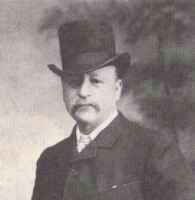
R. H. Blanton (collected by the Port Opening Museum)
Foreigners in the settlement had a close look at the situation in their own country, where pollution had progressed with the development of industry, and realized the importance of urban infrastructure development. At that time, cholera was prevalent in foreign countries and in Japan, so the drainage and sewerage of the settlement was a longing for the residents. At that time, digging was laid on the main road in Yokohama, which served as a sewer, but it was structurally poor, and in various places, that is, overflowing in various places, buried underground It was far beyond comparison with Western sewers, where sewage flows into pipes buried pipes.
After the Meiji New Government was born by the Meiji Restoration, based on the "Yokohama Residency Memorandum of Understanding" signed between consular consulars and the Shogunate in November 1864 (1864), it was the first foreigner to be employed.
The sewerage improvement plan for the settlement was started in 1869 and was completed in 1871 (1871). This sewer was to bury a sewer pipe made of tile ceramic pipe.
Installation of brick egg tubes
The number of foreigners residing in Kannai foreign settlement was 1071 in 1871 (1871), but in 1880 (1880), it increased dramatically to 3,937, and the amount of drainage exceeded the capacity of the sewer pipe. The sewage pipe was often clogged by various solids mixed with the sewage coming out of the foreigners, making it impossible to eliminate dirt. Also, from 1877 (1877) to 1879, cholera, which has reached 110,000 deaths, became widespread throughout the country, and sewerage renovation work was carried out.
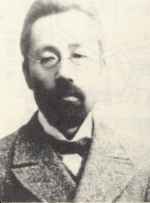
Zentaro Mita
In 1880, Kanagawa Prefecture began investigating and planning for renovation work, with Zentaro Mita, the person in charge of it. Mita Zentaro was born in Shimonokuni Shigeki in 1855 (1855) and entered Daigakuminami Campus (now the University of Tokyo) as a tribute to the Hitachi Yatabe clan. Mita, a first-year student at the Department of Civil Engineering, Faculty of Science at the University of Tokyo, became a civil engineering company in Kanagawa Prefecture in 1879 (1879).
Mita's design, which is said to have been invented by British John Philip, in 1846, was an egg-shaped tube with a ratio of 3 to 2. In order to ensure the flow velocity so as not to submerge the sewage pipe, the slope was 1/200, and the shape was egg-shaped so that the flow velocity did not fall even when water flow was low.
The egg-shaped pipe is a brick pipe made of brick and cement, and three types of brick pipes with different diameters were constructed as large sewage, medium sewage, and small sewage, respectively, with ceramic pipes on the main part.
The renovation work was carried out from 1881 (1881) to 1887, and about 4 km of brick egg-shaped tubes and 12.6 km ceramic tubes were laid. This sewer is Japan's first modern sewer, and Zentaro Mita can be said to be the first Japanese person to design a modern sewer system.
Brick-shaped egg tube structure (unit: shaku)
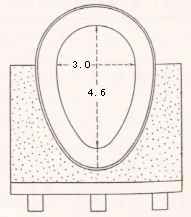
Large sewage
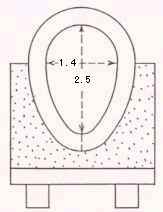
Sewage and sewage
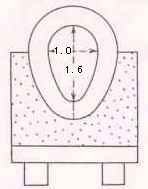
Small sewage
Preserving and utilization of brick egg tubes
The large sewage (brick egg pipe) discovered during the construction of NTT Pipeline in Yokohama-zeikan-mae in May 1996 was part of a 4km brick egg-shaped pipe constructed by Mita. The laying status of brick egg pipes is evident in the "Kannai Settlement Sewage Pipe Installation Map" created in 1899, and this is the first time that a large sewage has been discovered among them.
Many of the brick egg-shaped tubes have been modified with the development of the city, but they are likely to be discovered in the future. It is necessary to find a better way to preserve and utilize large sewage (brick egg tubes).
- Reference materials
- "Yokohama Sewer History" Published: Yokohama City Sewerage Bureau
- Published by "Japanese Sewerage History - Overview" Published: Japan Sewerage Association
For inquiries to this page
Sewage Works Management Division, Environmental Planning Bureau Sewerage Planning Coordination Department
Phone: 045-671-2840
Phone: 045-671-2840
Fax: 045-664-0571
Email address: ks-jigyomanagement@city.yokohama.jp
Page ID: 112-039-358







